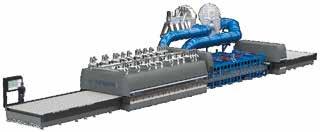ANALYSIS: Fenestration
Opening options
windows for today…and tomorrow
Carlos Machado e Moura and Pedro Borges de Araújo of Jofebar / panoramah!® and Centro de Estudos de Arquitectura e Urbanismo, Faculdade de Arquitectura da Universidade do Porto discuss how evolving window technology has created a range of new architectural options…if only some of the ideas could be combined…
W
indows have always been at the intersection of various technologies and architectural processes that evolved in parallel and often intertwined. Last century’s breakthroughs in terms of glass and frame allowed the glass to progressively absorb functions traditionally present in other devices ultimately dissolving the window into transparent walls. Nowadays, smart windows intersect previous technologies with electrically activated materials with dynamic properties augmenting their capacity. In this paper, we speculate on an idea of the window of the future according to state of the art in terms of glass and operable frames. We argue that a possible outcome of the combination of different technologies — magnetic and dynamic levitation, transparent photovoltaic glass, vacuum insulated glass, switchable glass, piezoelectric touch-sensitive surfaces or ultra-thin glass — might ultimately change the architectural approach to windows.
More glass, fewer windows?
Imagining the future of the window is not an easy task. It is not even clear whether windows, as single recognizable operable devices, will still exist. Emerging in western architecture as apertures punctured in enclosing walls to introduce light into buildings, admit air and provide framed views to the outside, they are spatial mediators of the relation between interior and exterior like glass doors, which additionally allow movement. Therefore they work as filters, being historically accompanied by a series of devices that regulate light, ventilation, privacy, and atmospherical conditions. Some provide shading — shutters, louvers, jealousies, blinds, screens and curtains —, others security — bars, grills, storm sashes, handles and bolts —, while others — seats, sills, bow-windows, meshes — express different architectural approaches, varying according to climate conditions, cultural roots and social issues Over time, designers envisioned new architectural possibilities for glass doors and windows, which evolved in parallel and often intertwined with various glass
38
asianglass AG 20-1
and frame technologies and frame. The window as a hole progressively faded away as last century’s improvements allowed the size of glass panes to grow, undifferentiating windows and glass doors, and culminating in the glass curtain wall, which simultaneously expanded the window encompassing the entire façade and dissolved it into fully glazed skins. Furthermore, during the 20th century, closed façades become prominent, especially in corporate buildings, with windows that provide uninterrupted views to the exterior but prevent any physical contact with it, as mechanized ventilation systems absorbed the function of air supply. Industrialization, on the other hand, sacrificed the genealogy of window and its local specificities, institutionalizing global practices and standard requirements of thermal efficiency, fire resistance, airtightness and waterproofness. Tempered glass also played an essential role in this evolution, allowing glazing to perform a structural function, which was until then prohibited. With all these changes, windows lost their autonomy as isolated elements and their role as visual framing agents. Glass as a screen wrapping (parts of) the façade replaced the anthropomorphic metaphor of windows as the “eyes” of the building, challenging the traditional concept of window.
www.asianglass.com








